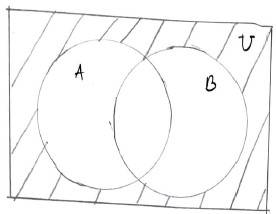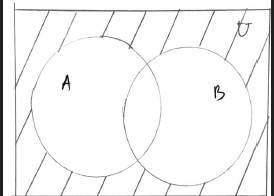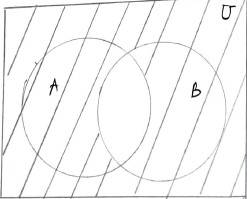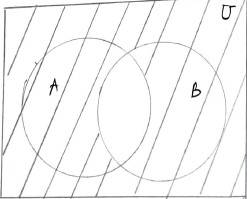Sets
Get insights from 134 questions on Sets, answered by students, alumni, and experts. You may also ask and answer any question you like about Sets
Follow Ask QuestionQuestions
Discussions
Active Users
Followers
New answer posted
6 months agoContributor-Level 10
38. (i) (A B) = U – (A B)

(ii) A ∩ B = (AU B) = U – (AU B)



New answer posted
6 months agoContributor-Level 10
37. (i) L.H.S = (A B) = U – (A B)
= {1,2,3,4,5,6,7,8,9} – [ {2,4,6,8) {2,3,5,7}]
= {1,2,3,4,5,6,7,8,9} – {2,3,4,5,6,7,8}
= {1,9}
R.H.S. = A ∩ B = [U – A] ∩ [U B]
= ∩
= {1,3,5,7,9} ∩ {1,4,6,8,9}
= {1,9}
? L.H.S. = R.H.S.
(A B) = A ∩ B.
(ii) L.H.S. = (A ∩ B) = U – (A ∩ B)
= {1,2,3,4,5,6,7,8,9} – [ {2,4,6,8} ∩ {2,3,5,7}]
= {1,2,3,4,5,6,7,8,9} – {2}
= {1,3,4,5,6,7,8,9}
R.H.S. = A B
= [U – A] [U – B]
= [ {1,2,3,4,5,6,7,8,9} – {2,4,6,8}] [ {1,2,3,4,5,6,7,8,9} – {2,3,5,7}]
= {1,3,5,7,9} {1,4,6,8,9}
= {1,3,4,5,6,7,8,9}
? L.H.S. = R.H.S.
(A ∩ B) = A B.
New answer posted
6 months agoContributor-Level 10
3. (i) {x : x is an odd natural number}
(ii) {x : x is an even natural number}
(iii) {x : x is not a multiple of 3}
(iv) {x : x is a positive composite number and x = 1}
(v) {x : x is a natural number not divisible by 3 and 5}.
(vi) {x : x is not a perfect square}
(vii) {x : x is not a perfect cube}
(viii) We have, x + 5 = 8.
x = 8 – 5 = 3
x = 3
? {x : x ≠ 3, x? N}
(ix )We have,
2x + 5 = 9
2x = 9 – 5
2x = 4
x = 2
? {x : x? N and x ≠ 2}
(x) {x : x < 7} = {1,2,3,4,5,6}
(xi) We have,
2x + 1 >10
2x >10 – 1
x >
? = {1,2,3,4}
New answer posted
6 months agoContributor-Level 10
35. (i) A = U – A = {a, b, c, d, e, f, g, h} – {a, b, c}
= {d, e, f, g, h}
(ii) B = U – B = {a, b, c, d, e, f, g, h} – {d, e, f, g}
= {a, b, c, h}.
(iii) C = U – C = {a, b, c, d, e, f, g, h} – {a, c, e, g}.
= {b, d, f, h}
(iv) D = U – D = {a, b, c, d, e, f, g, h} – {f, g, h, a}
= {b, c, d, e}
New answer posted
6 months agoContributor-Level 10
34. (i) A = U – A = {1,2,3,4,5,6,7,8,9} – {1,2,3,4}
= {5,6,7,8,9}
(ii) B = U – B = {1,2,3,4,5,6,7,8,9} – {2,4,6,8}
= {1,3,5,7,9}.
(iii) (A C) = A ∩ C
= {5,6,7,8,9} ∩ [U – C] [? (i)]
= {5,6,7,8,9} ∩ [ {1,2,3,4,5,6,1,8,9} – {3,4,5,6}]
= {5,6,7,8,9} ∩ {1,2,7,8,9}
= {7,8,9}
(iv) A B) = A ∩ B [By demorgan's law]
= {5,6,7,8,9} ∩ {1,3,5,7,9} [? (i) and (ii)]
= {5,7,9}.
(v) (A) = U – A = {1,2,3,4,5,6,7,8,9} – {5,6,7,8,9} [? (1)]
= {1,2,3,4} = A
(A) = A.
(vi) (B – C) = U – (B – C) = {1,2,3,4,5,6,7,8,9} – [ {2, 4, 6, 8} – {3, 4, 5, 6}]
= {1,2,3,4,5,6,7,8,9} – {2,8}
= {1,3,4, 5, 6,7,9}.
New answer posted
6 months agoContributor-Level 10
33. (i) False, as {2,3,4,5} ∩ {3,6} = {3} ≠ .Hence sets are not disjoint.
(ii) False as {a, e, i, o, u} ∩ {a, b, c, d} = {a} ≠ Hence sets are not disjoint.
(iii) True as {2,6,10,14} ∩ {3,7,11,15} = . Hence sets are disjoint.
(iv) True as {2,6,10} ∩ {3,7,11}= . Hence sets are disjoint.
New answer posted
6 months agoContributor-Level 10
32. R – Q = {x: x is a real number but not rational number}
= {x: x is an irrational number}
Since real number = rational number + irrational number
New answer posted
6 months agoContributor-Level 10
31. (i) X – Y = {a, b, c, d} – (f, b, d, g}
= {a, c}
(ii) Y – X = {f, b, d, g} – {a, b, c, d}
= {f, g}
(iii) X ∩ Y = {a, b, c, d} ∩ {f, b, d, g}
= {b, d}.
New answer posted
6 months agoContributor-Level 10
30. (i) A – B = {3,6,9,12,15,18,21} – {4,8,12,16,20}
= {3,6,9,15,18,21}
(ii) A – C = {3,6,9,12,15,18,21} – {2,4,6,8,10,12,14,16}
= {3,9,15,18,21}
(iii) A – D = {3,6,9,12,15,18,21} – {5,10,15,20}
= {3,6,9,12,18,21}
(iv) B – A = {4,8,12,16,20} – {3,6,9,12,15,18,21}
= {4,8,16,20}
(v) C – A = {2,4,6,8,10,12,14,16} – {3,6,9,12,15,18,21}
= {2,4,8,10,14,16}
(vi) D – A = {5,10,15,20} – {3,6,9,12,15,18,21}
= {5,10,20}
(vii) B – C= {4,8,12,16,20} – {2,4,6,8,10,12,14,16}
= {20}
(viii) B – D = {4,8,12,16,20} – {5,10,15,20}
= {4,8,12,16}
(ix) C – B = {2,4,6,8,10,12,14,16} – {4,8,12,16,20}
= {2,6,10,14}
(x) D – B = {5,1
New answer posted
6 months agoContributor-Level 10
29. (i) {1,2,3,4} ∩ {x : x is a natural number and 4 ≤ x ≤ 6}
{1, 2, 3, 4} ∩ {4, 5, 6}
{4} ≠∅
Hence, the given pair of set is not disjoint.
(ii) {a, e, i, o, u} ∩ {c, d, e, f}
{e} ≠∅
Hence, the given pair of set is not disjoint.
(iii) {x: x is an even integer} ∩ {x: x is are odd integer}.
=∅
As there is no integer which is both even and odd at the same time.
? Given pair of set are disjoint.
Taking an Exam? Selecting a College?
Get authentic answers from experts, students and alumni that you won't find anywhere else
Sign Up on ShikshaOn Shiksha, get access to
- 65k Colleges
- 1.2k Exams
- 679k Reviews
- 1800k Answers
